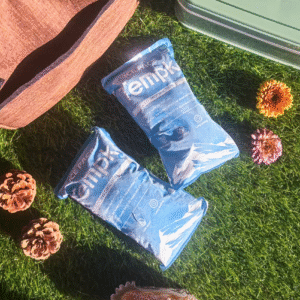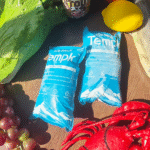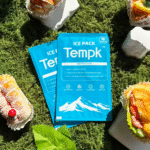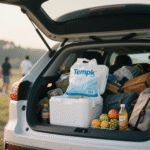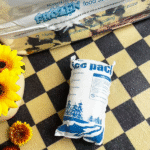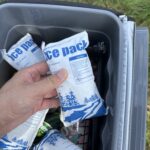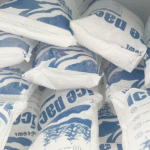Meilleur pack de glace carbonique: Comment choisir dans 2025
Mis à jour: Octobre 13, 2025
Trouver le meilleur pack de glace carbonique commence par la sécurité et se termine par la prévisibilité. Dans la première boîte que tu emballes, assurer ventilation, correct UN1845 étiquetage de l'air, et un ajustement qui maintient les marchandises congelées sans ruptures ni retouches. Vous réduirez les pertes, chèques d'acceptation de passage, et expédiez en toute confiance, voie après voie.
-
Comment le meilleur pack de glace carbonique éviter les rafales et réussir les contrôles?
-
De quelle quantité de neige carbonique ou de gel avez-vous besoin 24–72 heures?
-
Quels matériaux, épaisseurs, et les chemins de ventilation fonctionnent mieux sur de vraies voies?
-
Quand le gel/PCM est-il le meilleur choix que la glace carbonique pour les cibles réfrigérées ??
-
Quoi 2025 les innovations comptent: bouches d'aération intelligentes, mono-matériaux, et validation numérique?
Qu'est-ce qui fait que meilleur pack de glace carbonique plus sûr et conforme?
Réponse courte: Ventilation, ajuster, et durabilité. Le meilleur pack de glace carbonique comprend toujours un chemin de ventilation contrôlé, utilise un sac qui s'adapte au bloc ou aux pellets sans trop sceller, et survit aux chutes et aux vibrations dans l'automatisation. Les colis ne doivent pas être hermétiques, et les sacs intérieurs sont plié, non scellé—un détail réussite/échec sur les listes de contrôle d'acceptation.
Pourquoi cela compte pour vous: La neige carbonique sublime et produit du gaz. Un sac scellé emprisonne la pression et peut se rompre, endommager l'expéditeur, ou échouer à l'acceptation. Le pack standard le plus sûr utilise sacs intérieurs faciles à aérer et un expéditeur extérieur ventilé, marqué UN1845 avec poids net pour l'air. Ce seul changement réduit considérablement les retouches et les réclamations sur les voies gelées..
Choix de matériaux pour le meilleur pack de glace carbonique
| Matériel | Barrière | Comportement de ventilation | Durabilité | Ce que cela signifie pour vous |
|---|---|---|---|---|
| PEHD 5 à 6 mil | Moyen | Équilibré | Haut | Robuste en automatisation, bon polyvalent. |
| PEBD 4 à 5 mil | Moyen-bas | Bien | Flexible | Manipulation plus facile; il faut encore une ventilation pliable. |
| Métallisé/mylar | Haut | Bas sans aérations | Très élevé | À utiliser uniquement avec des micro-aérations ou des espaces pliés. |
| Carton + Stratifiés PE | Moyen | Naturellement ventilé | Modéré | Un choix éco-responsable; idéal pour les pellets/blocs. |
Conseils pratiques que vous pouvez appliquer aujourd'hui
-
Pli, Ne sceller pas tout sac intérieur contenant de la neige carbonique.
-
Gardez une vue claire canal d'espace de tête des sacs intérieurs à l’évent/prise de l’expéditeur.
-
Marquer les expéditions aériennes «Dioxyde de carbone, solide (UN1845)» avec Kg net.
-
Formez les équipes avec la phrase "le colis est ventilé."
Cas réel: Une marque alimentaire nationale est passée des pochettes en film scellées aux sacs pliés en PEHD plus un refroidisseur ventilé. Ils ont réduit les ruptures et les retouches tout en améliorant les livraisons à temps à deux chiffres sur les voies d'été..
Quelle quantité de meilleur pack de glace carbonique Avez-vous besoin?
Réponse courte: Commencez par un règle empirique basée sur les voies puis validez. Pour les voies gelées, planifier approximativement 5–10 lb par 24 heures par expéditeur, en fonction de l'isolation et de l'environnement. Pour réfrigéré (0–8 ° C), utiliser du gel/PCM dimensionné en fonction des heures et de la charge thermique; vous n'avez pas besoin du UN1845 pour les expéditeurs de gel uniquement.
Développer: Les blocs durent plus longtemps que les pellets en raison de leur surface inférieure, alors choisissez des blocs pour les longues prises et des pellets pour un retrait rapide et un remplissage rapide. Divisez toujours la masse totale en six postes (bas/côtés/haut) pour stabiliser les températures et préserver les chemins de ventilation. Connectez-vous et réglez par saison.
Règles de dimensionnement pour 24 à 72 heures (commence ici)
| Cible | Emballage typique | Masse de planification | Que régler |
|---|---|---|---|
| 24 h gelé | 2 bas, 2 côtés, 2 haut | ~5 à 10 lb au total | Ajouter un capuchon en mousse; assurer le chemin de ventilation. |
| 48 h gelé | Six points avec blocs | ~10 à 20 livres | Préférez les blocs aux pellets. |
| 72 h gelé | Six points + doublure | ~20 à 30 livres | Améliorer l'isolation avant la messe. |
| 24–48 h au frais | 6 Briques en gel (600–900g) | 4–6 unités | Passez à des PCM à latence plus élevée pour la chaleur. |
Un estimateur pratique (intégration facultative)
Meilleur pack de glace carbonique vs pack de gel : quand devriez-vous choisir chacun?
Réponse directe: Utiliser le meilleur pack de glace carbonique (vraie glace carbonique dans un emballage ventilé) pour congelé cibles. Utiliser packs de gel/PCM pour 0–8 ° C. De nombreuses listes en ligne de « blocs de glace carbonique » signifient gel/PCM et ne sont pas réglementées comme le CO₂.. Choisir par la température d'abord, puis ajustement et conformité.
Contexte: La glace carbonique nécessite des sacs ventilés et un emballage extérieur ventilé avec UN1845 marques pour l'air. Gel/PCM ne nécessite rien de tout cela, mais il ne peut pas garder les marchandises congelées. Évitez de mélanger, sauf si vous passez aux SOP de glace carbonique.
Comparaison en un coup d'œil
| But | « Meilleur » choix | Pourquoi | Attention | Pour toi |
|---|---|---|---|---|
| Gardez les marchandises congelées | Meilleur pack de glace carbonique (ventilé intérieur + expéditeur ventilé) | Tenue gelée la plus forte | Ne scellez jamais les sacs en plastique; laisser les bouches d'aération ouvertes | Moins d'échecs sur les longues voies. |
| Conserver les marchandises entre 0 et 8 °C | Briques Gel/PCM | Formation simple; pas UN1845 | Ne tiendra pas gelé | Réduction du fardeau opérationnel; emballage plus rapide. |
Meilleur pack de glace carbonique des colis qui réussissent les contrôles (24–72 h)
Réponse courte: Le modèle le plus indulgent est le paquet en six points—deux en bas, deux côtés, deux sur le dessus, plus un canal d'espace libre vers l'évent ou le drain de l'expéditeur. Les sacs intérieurs sont pliés, non scellé. Étiquette UN1845 avec kg net pour les expéditions aériennes.
Comment le construire
-
Peser & diviser le CO₂ total (règle générale ci-dessus).
-
Emballez correctement: sacs kraft ou film plié; ne le faites pas thermosoudage.
-
Lieu 2 bas, 2 côtés, 2 en haut autour de la charge utile (pas de contact direct avec les primaires).
-
Ajouter capuchon en mousse et maintenir un canal de ventilation au bouchon/évent du refroidisseur.
-
Vérifier étiquettes et articles d'acceptation (Par exemple, « le colis est ventilé »).
Des tests de durabilité qui sauvent les réclamations
| Test | Cible | Votre avantage |
|---|---|---|
| Baisse (1.2 m) | Pas de rupture | Aucune pollution, moins de réemballages. |
| Augmentation de la pression | ≤0,2 barre | Confirme une évacuation sûre du CO₂. |
| 100+ choix | Pas de déchirure | Prêt pour l'automatisation. |
| Humidité/basse température | Pas de fissure | Résiste à −78 °C. |
2025 tendances pour le meilleur pack de glace carbonique
Quoi de neuf: Films de ventilation intelligents, mono-matériaux recyclables, lots suivis de carbone, et Modélisation par sublimation assistée par l'IA vous aider à expédier de manière plus sûre et plus écologique sans ajouter de main d'œuvre. Ces innovations redéfinissent ce que « meilleur » signifie cette année.
Dernier en un coup d'œil
-
Évents intelligents: Les pores qui s'ouvrent sous la pression réduisent le risque d'éclatement sur les voies aériennes.
-
Packs mono-matériau: Recyclage plus facile et reporting ESG plus propre.
-
Traçage numérique du CO₂: Les lots QR alimentent les audits Scope-3.
Perspicacité du marché: Les expéditeurs standardisent configurations ventilées et langue de la liste de contrôle (« le colis est ventilé ») pour accélérer l'acceptation et la formation : une petite modification de la documentation qui génère des gains de conformité considérables.
Questions fréquemment posées
Q1: Quelle est la caractéristique la plus importante du meilleur pack de glace carbonique?
UN chemin de ventilation contrôlé-sac intérieur plié plus un expéditeur extérieur ventilé. C’est le cœur de la sécurité et de l’acceptation.
Q2: Puis-je thermosceller un sac en film pour contenir des chips?
Non. Ne pas placez de la glace carbonique dans sacs en plastique scellés. Pliez la bouche ou utilisez des sacs kraft pour que le CO₂ puisse s'échapper.
Q3: Packs de gel vs meilleur pack de glace carbonique : comment choisir?
Choisir par température cible: gel/PCM pour 0 à 8 °C; glace carbonique pour surgelés. Ensuite, dimensionnez la masse et choisissez les matériaux pour votre voie.
Q4: Combien de glace sèche pour 48 heures?
Commencer 10–20 lb, préférez les blocs, puis testez avec des enregistreurs de données et ajustez selon la saison.
Q5: Quelles étiquettes sont requises pour l'air?
Marque «Dioxyde de carbone, solide (UN1845)» avec poids net et assurer la le paquet est ventilé.
Résumé & Recommandations
Résumer: Le meilleur pack de glace carbonique est un configuration ventilée qui maintient les marchandises congelées sans sceller le CO₂, utilise des matériaux qui survivent à la manipulation, et suit UN1845 et le langage d'acceptation. Dosage de la bonne taille avec des dispositions en six points, puis validez et documentez.
Étapes suivantes:
-
Temps de voie et température ambiante sur la carte; 2) Choisissez le type de pack (glace carbonique vs gel); 3) Définir la ventilation et les étiquettes; 4) Pilote et journal; 5) Standardiser les SOP; 6) Revoir ESG et recyclabilité. Besoin d'une SOP d'une page ou d'un dimensionnement des voies? Contactez notre équipe.
À propos du tempk
Nous concevons et validons emballage chaîne du froid pour la performance et la durabilité. Notre portefeuille s'étend HDPE, métallisé, et stratifié kraft options avec évents techniques, ainsi que des solutions gel/PCM pour les voies réfrigérées, toutes validées pour la logistique réelle. Nous aidons les 3PL et les expéditeurs à réduire leurs déchets, prévenir les ruptures, et atteindre les objectifs ESG. Parlez à nos ingénieurs pour obtenir des spécifications spécifiques à la voie.






